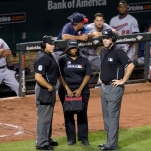Robots were able to make pancakes and pizza after reading Wikihow articles
When you want to learn how to change a tire or whip up some delicious strawberry buttermilk frosting, you likely turn to YouTube or a how-to wiki on the web.
Robots it turns out, can be programmed to do the same thing. A team of researchers in Germany taught a robot to turn to the web for instructional videos and step-by-step tutorials to complete simple tasks, like making pancakes and cooking a pizza. The incredible part of this is how the researchers programmed the robots to understand what they were seeing and reading. Engineers have to translate our world into language robots can understand. That requires breaking down sentences and actions in videos into mathematical equations which robots can use to tease out patterns in their “brains.”
-

-

-

-

-

-

-

-

-

-

-

-

-

-

-

-

-

-

-

-

-

-

-

-

-

-

-

-

-

-

-

-

-

-

-

-

-

-

-

-

-

-

-

-

-

-

-

-

-

-

-

-

-

-

-

-

-

-

-

-

-

-

-

-

-

-

-

-

-

-

-

-

-

-

-

-

-

-

-

-

-

-

-

-

-

-

-

-

-

-

-

-

-

-

-

-

-

-

-

-

-

-

-

-

-

-

-

-












































































































